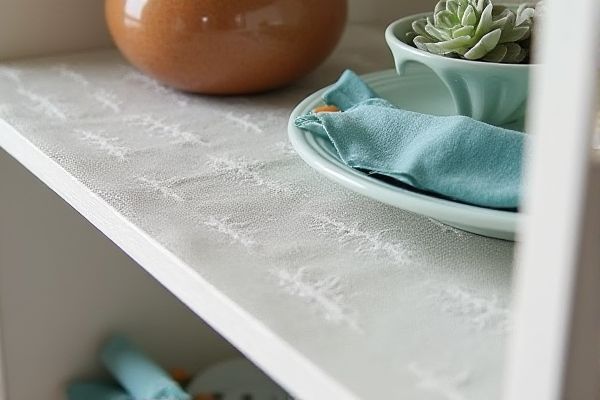
Mesh shelf liners offer superior airflow and prevent moisture buildup, keeping your shelves dry and reducing the risk of mold, while plastic liners provide a waterproof barrier that's easy to clean and protect against spills. Understanding the benefits and drawbacks of each liner type can help you choose the best option for Your storage needs--read on to explore the details.
Table of Comparison
| Feature | Mesh Shelf Liners | Plastic Shelf Liners |
|---|---|---|
| Material | Breathable polyester or nylon mesh | Non-porous PVC or polyethylene plastic |
| Airflow | Allows air circulation, reduces moisture buildup | Blocks airflow, can trap moisture |
| Water Resistance | Resistant but can allow some seepage | Fully waterproof and easy to clean |
| Cleaning | Machine washable, dries quickly | Wipeable with detergent |
| Non-slip | Moderate grip, may require double layering | Strong grip on shelves and items |
| Durability | Durable but can fray over time | Highly durable and tear-resistant |
| Use Cases | Ideal for ventilation-sensitive items, pantry shelves | Best for moisture-prone areas, drawers, or spills |
| Environmental Impact | Often biodegradable or recyclable | Generally less eco-friendly, harder to recycle |
| Cost | Typically medium price range | Usually low to medium cost |
Mesh Shelf Liners vs Plastic Liners: An Overview
Mesh shelf liners provide superior airflow and moisture drainage, preventing mold and mildew buildup often seen with plastic liners. Plastic liners offer a waterproof barrier and are easier to clean but can trap moisture, leading to potential damage to wood surfaces. Choosing between mesh and plastic liners depends on the need for breathability versus impermeability in shelf protection.
Material Composition: Mesh vs Plastic
Mesh shelf liners are typically made from woven polyester or nylon fibers, providing breathability and allowing air circulation to prevent moisture buildup and mold growth. Plastic liners, often constructed from vinyl or polyethylene, offer a waterproof barrier that protects shelves from spills and stains but can trap moisture, leading to potential mold issues. The porous nature of mesh liners supports ventilation and shelf maintenance, while plastic liners prioritize impermeability and easy cleaning.
Installation and Fit: Which Is Easier?
Mesh shelf liners offer a flexible and adjustable fit, easily trimmed to match the exact dimensions of your shelves, making installation straightforward without requiring adhesives or tools. Plastic liners, while providing a rigid and waterproof barrier, often require precise measurements and careful cutting to ensure a smooth fit, which can be more time-consuming and less forgiving during installation. Your choice depends on whether you prioritize ease of customization and quick setup or a sturdy, moisture-resistant surface.
Durability and Longevity Comparison
Mesh shelf liners offer superior durability compared to plastic liners, as their breathable design resists tearing and warping over time. Plastic liners tend to crack and become brittle with prolonged exposure to moisture and temperature changes, reducing their longevity. Choosing mesh liners enhances shelf protection while ensuring Your kitchen organization remains intact for years.
Cleaning and Maintenance Requirements
Mesh shelf liners are more breathable and less prone to trapping moisture, making them easier to clean and less likely to develop mold or mildew compared to plastic liners. Plastic liners can accumulate spills and dirt on their non-porous surface, requiring more frequent wiping and careful drying to prevent bacterial growth. Choosing mesh liners can reduce maintenance time while keeping your shelves cleaner and fresher.
Breathability and Moisture Control
Mesh shelf liners offer superior breathability compared to plastic liners, allowing air to circulate freely and reducing moisture buildup. This ventilation helps prevent mold, mildew, and unpleasant odors by keeping shelves dry and well-aerated. In contrast, plastic liners trap moisture, which can lead to condensation and increased risk of damage to stored items.
Slip Resistance and Stability
Mesh shelf liners offer superior slip resistance and stability compared to plastic liners due to their textured surface, which helps keep items securely in place. They allow air circulation, preventing moisture buildup and reducing the risk of items sliding or shifting. Your shelves will benefit from enhanced grip and durability when using mesh liners over smooth plastic alternatives.
Environmental Impact and Sustainability
Mesh shelf liners offer superior environmental benefits compared to plastic liners due to their reusable and breathable design, which reduces waste and promotes longer product lifespan. Plastic liners contribute significantly to landfill pollution and take centuries to decompose, leaching harmful chemicals into the environment during breakdown. Choosing mesh liners supports sustainability by minimizing single-use plastic consumption and enhancing eco-friendly household practices.
Best Uses for Mesh and Plastic Shelf Liners
Mesh shelf liners are ideal for ventilated storage areas, such as under-sink shelves or pantry racks, because they allow air circulation that prevents mold and mildew buildup. Plastic liners excel in protecting shelves from spills, stains, and moisture, making them perfect for kitchen cabinets, bathroom drawers, or areas prone to water exposure. Your choice between mesh and plastic shelf liners should consider the ventilation needs and the type of protection required for your storage space.
Choosing the Right Shelf Liner for Your Needs
Mesh shelf liners provide breathability and prevent moisture buildup, making them ideal for storing produce and items prone to mold. Plastic liners offer durability and waterproof protection, perfect for shielding shelves from spills and heavy-duty use. Selecting the right shelf liner depends on whether ventilation or waterproofing is the priority in your storage environment.
 homyna.com
homyna.com